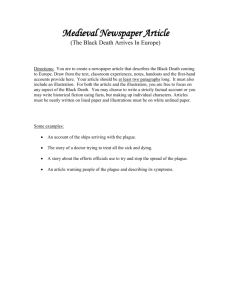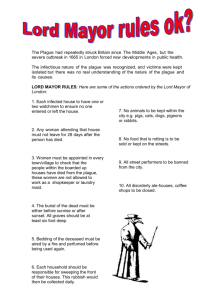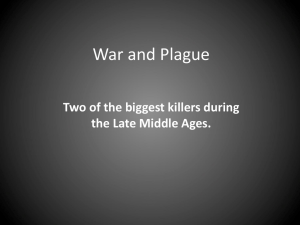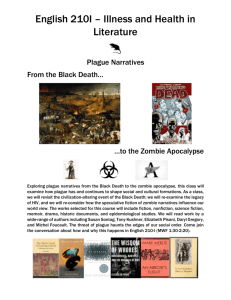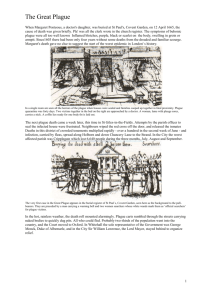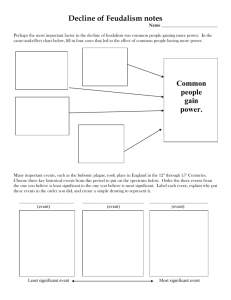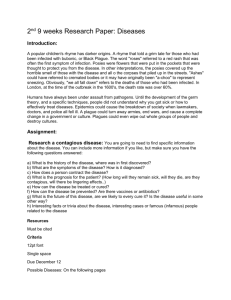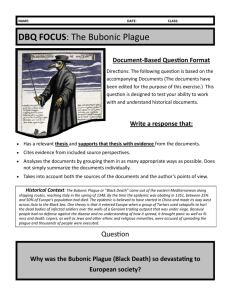Plague Document Analysis
advertisement
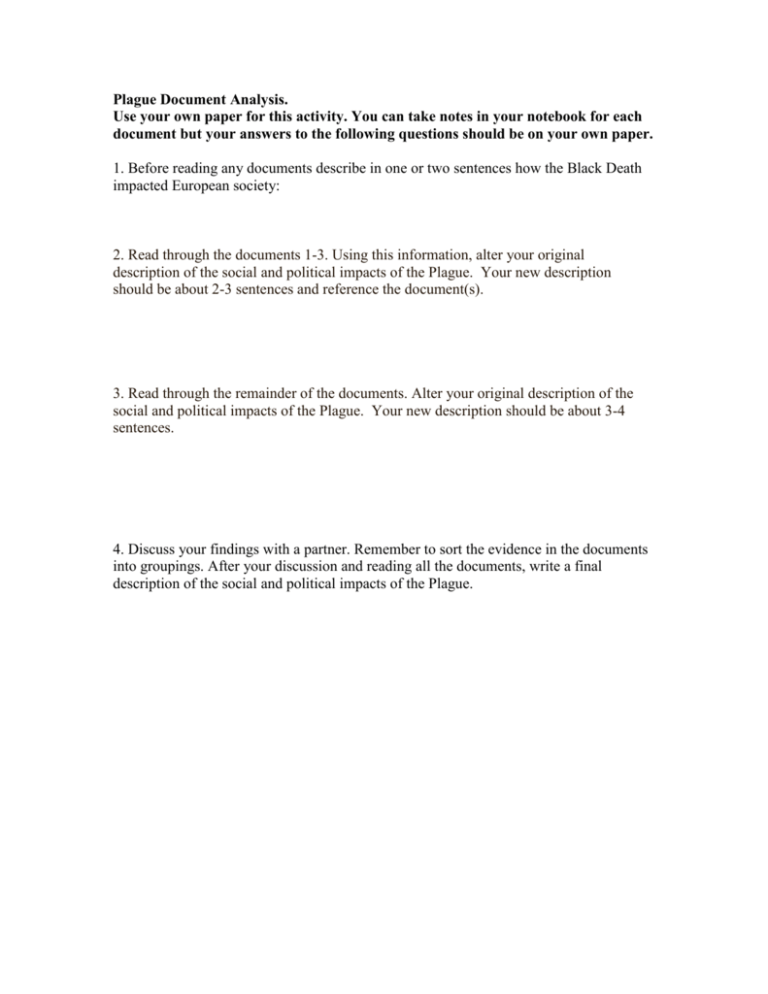
Plague Document Analysis. Use your own paper for this activity. You can take notes in your notebook for each document but your answers to the following questions should be on your own paper. 1. Before reading any documents describe in one or two sentences how the Black Death impacted European society: 2. Read through the documents 1-3. Using this information, alter your original description of the social and political impacts of the Plague. Your new description should be about 2-3 sentences and reference the document(s). 3. Read through the remainder of the documents. Alter your original description of the social and political impacts of the Plague. Your new description should be about 3-4 sentences. 4. Discuss your findings with a partner. Remember to sort the evidence in the documents into groupings. After your discussion and reading all the documents, write a final description of the social and political impacts of the Plague. Document 1 Source: Michael Platiensis (1357), quoted in Johannes Nohl, The Black Death, trans. C.H. Clarke (London: George Allen & Unwin Ltd., 1926), pp. 18-20. “At the beginning of October, in the year of the incarnation of the Son of God 1347, twelve Genoese galleys . . . entered the harbor of Messina. In their bones they bore so virulent a disease that anyone who only spoke to them was seized by a mortal illness and in no manner could evade death. The infection spread to everyone who had any contact with the diseased. Those infected felt themselves penetrated by a pain throughout their whole bodies and, so to say, undermined. Then there developed on the thighs or upper arms a boil about the size of a lentil which the people called "burn boil". This infected the whole body, and penetrated it so that the patient violently vomited blood. This vomiting of blood continued without intermission for three days, there being no means of healing it, and then the patient expired. Not only all those who had speech with them died, but also those who had touched or used any of their things. When the inhabitants of Messina discovered that this sudden death emanated from the Genoese ships they hurriedly ordered them out of the harbor and town. But the evil remained and caused a fearful outbreak of death. Soon men hated each other so much that if a son was attacked by the disease his father would not tend him. If, in spite of all, he dared to approach him, he was immediately infected and was bound to die within three days. Nor was this all; all those dwelling in the same house with him, even the cats and other domestic animals, followed him in death. As the number of deaths increased in Messina many desired to confess their sins to the priests and to draw up their last will and testament. But ecclesiastics, lawyers and notaries refused to enter the houses of the diseased. Soon the corpses were lying forsaken in the houses. No ecclesiastic, no son, no father and no relation dared to enter, but they hired servants with high wages to bury the dead. The houses of the deceased remained open with all their valuables, gold and jewels. . . . When the catastrophe had reached its climax the Messinians resolved to emigrate. One portion of them settled in the vineyards and fields, but a larger portion sought refuge in the town of Catania. The disease clung to the fugitives and accompanied them everywhere where they turned in search of help. Many of the fleeing fell down by the roadside and dragged themselves into the fields and bushes to expire. Those who reached Catania breathed their last in the hospitals there. The terrified citizens would not permit the burying of fugitives from Messina within the town, and so they were all thrown into deep trenches outside the walls.” Document 2 Source: recommendations from Paris medical faculty to the Pope, 1348. No poultry should be eaten, no waterfowl, no pig, no old beef, altogether no fat meat. . . . It is injurious to sleep during the daytime. . . . Fish should not be eaten, too much exercise may be injurious . . . and nothing should be cooked in rainwater. Olive oil with food is deadly. . . . Bathing is dangerous. . . Document 3 Painting of plague victims. Document 4 Source: History of England by Henry Knighton, in Source Book of English History, by E.K. Kendall "Then the grievous plague penetrated the seacoasts from Southampton, and came to Bristol, and there almost the whole strength of the town died, struck as it were by sudden death. There died at Leicester in the small parish of St. Leonard more than 380, in the parish of Holy Cross more than 400; in the parish of S. Margaret of Leicester more than 700; and so in each parish a great number. Then the bishop of Lincoln gave general power to all and every priest to hear confessions, and absolve with full and entire authority except in matters of debt, in which case the dying man, if he could, should pay the debt while he lived, or others should certainly fulfill that duty from his property after his death…Meanwhile the king sent proclamation that reapers and other laborers should not take more than they had been accustomed to take (in pay). But the labourers were so lifted up and obstinate that they would not listen to the king's command, but if anyone wished to have them he had to give them what they wanted, and either lose his fruit and crops, or satisfy the wishes of the workmen.” Document 5 Painting of a medieval doctor Document 6 Drawing circa 14th Century Document 7 Source: Agnolo di Tura, of Siena: "The mortality in Siena began in May. It was a cruel and horrible thing. . . . It seemed that almost everyone became stupefied seeing the pain. It is impossible for the human tongue to recount the awful truth. Indeed, one who did not see such horribleness can be called blessed. The victims died almost immediately. They would swell beneath the armpits and in the groin, and fall over while talking. Father abandoned child, wife husband, one brother another; for this illness seemed to strike through breath and sight. And so they died. None could be found to bury the dead for money or friendship. Members of a household brought their dead to a ditch as best they could, without priest, without divine offices. In many places in Siena great pits were dug and piled deep with the multitude of dead. And they died by the hundreds, both day and night, and all were thrown in those ditches and covered with earth. And as soon as those ditches were filled, more were dug. I, Agnolo di Tura . . . buried my five children with my own hands. . . . And so many died that all believed it was the end of the world." Document 8 Map of the spread of plague and trade routes.
